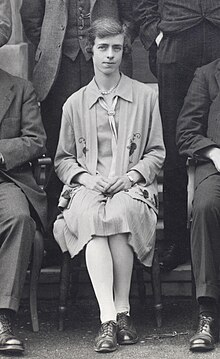Beryl May Dent | |
|---|---|
 Dent in 1928 | |
| Born | 10 May 1900 Chippenham, Wiltshire, England |
| Died | 9 August 1977 (aged 77) Worthing, West Sussex, England |
| Resting place | Worthing Crematorium (ashes interred) |
| Alma mater | |
| Awards | Ashworth Hallett scholarship (1923) |
| Scientific career | |
| Fields |
Other fields |
| Institutions |
|
| Thesis | Some theoretical determinations of crystal structure (1927) |
| Academic advisors | John Lennard-Jones |
Beryl May Dent MIEE (10 May 1900 – 9 August 1977) was an English mathematical physicist, technical librarian, and a programmer of early analogue and digital computers to solve electrical engineering problems. She was born in Chippenham, Wiltshire, the eldest daughter of schoolteachers. The family left Chippenham in 1901, after her father became head teacher of the then recently established Warminster County School. In 1923, she graduated from the University of Bristol with First Class Honours in applied mathematics. She was awarded the Ashworth Hallett scholarship by the university and was accepted as a postgraduate student at Newnham College, Cambridge.
She returned to Bristol in 1925, after being appointed a researcher in the Physics Department at the University of Bristol, with her salary being paid by the Department of Scientific and Industrial Research. In 1927, John Lennard-Jones was appointed Professor of Theoretical physics, a chair being created for him, with Dent becoming his research assistant in theoretical physics. Lennard‑Jones pioneered the theory of interatomic and intermolecular forces at Bristol and she became one of his first collaborators. They published six papers together from 1926 to 1928, dealing with the forces between atoms and ions, that were to become the foundation of her master's thesis. Later work has shown that the results they obtained had direct application to atomic force microscopy by predicting that non-contact imaging is possible only at small tip-sample separations.
In 1930, she joined Metropolitan-Vickers Electrical Company Ltd, Manchester, as a technical librarian for the scientific and technical staff of the research department. She became active in the Association of Special Libraries and Information Bureaux (ASLIB) and was honorary secretary to the founding committee for the Lancashire and Cheshire branch of the association. She served on various ASLIB committees and made conference presentations detailing different aspects of the company's library and information service. She continued to publish scientific papers, contributing numerical methods for solving differential equations by the use of the differential analyser that was built for the University of Manchester and Douglas Hartree. She was the first to develop a detailed reduced major axis method for the best fit of a series of data points.
Later in her career she became leader of the computation section at Metropolitan-Vickers, and then a supervisor in the research department for the section that was investigating semiconducting materials. She joined the Women's Engineering Society and published papers on the application of digital computers to electrical design. She retired in 1960, with Isabel Hardwich, later a fellow and president of the Women's Engineering Society, replacing her as section leader for the women in the research department. In 1962, she moved with her mother and sister to Sompting, West Sussex, and died there in 1977.
© MMXXIII Rich X Search. We shall prevail. All rights reserved. Rich X Search
